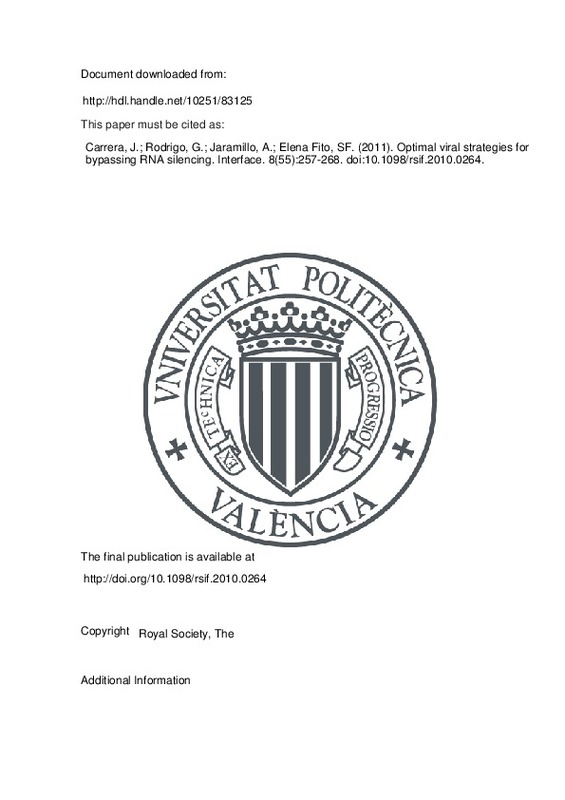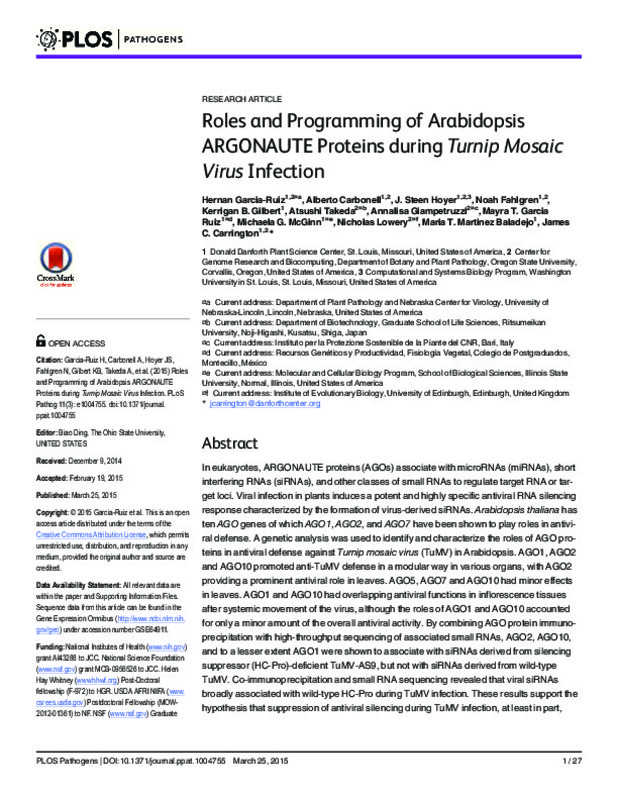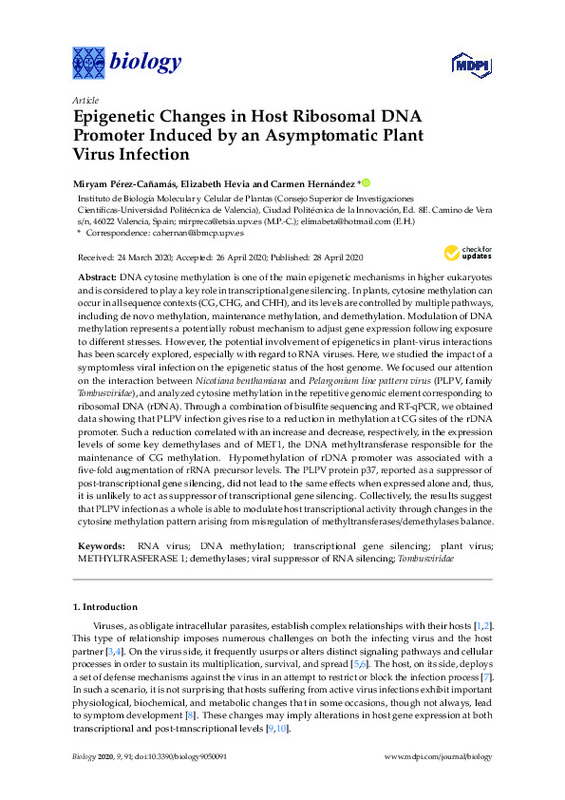JavaScript is disabled for your browser. Some features of this site may not work without it.
Buscar en RiuNet
Listar
Mi cuenta
Estadísticas
Ayuda RiuNet
Admin. UPV
Optimal viral strategies for bypassing RNA silencing
Mostrar el registro sencillo del ítem
Ficheros en el ítem
| dc.contributor.author | Rodrigo Tarrega, Guillermo
|
es_ES |
| dc.contributor.author | Carrera, Javier
|
es_ES |
| dc.contributor.author | Jaramillo, Alfonso
|
es_ES |
| dc.contributor.author | Elena Fito, Santiago Fco
|
es_ES |
| dc.date.accessioned | 2017-06-19T07:06:34Z | |
| dc.date.available | 2017-06-19T07:06:34Z | |
| dc.date.issued | 2011-02-06 | |
| dc.identifier.issn | 1742-5689 | |
| dc.identifier.uri | http://hdl.handle.net/10251/83125 | |
| dc.description.abstract | [EN] The RNA silencing pathway constitutes a defence mechanism highly conserved in eukaryotes, especially in plants, where the underlying working principle relies on the repressive action triggered by the intracellular presence of double-stranded RNAs. This immune system performs a post-transcriptional suppression of aberrant mRNAs or viral RNAs by small interfering RNAs (siRNAs) that are directed towards their target in a sequence-specific manner. However, viruses have evolved strategies to escape from silencing surveillance while promoting their own replication. Several viruses encode suppressor proteins that interact with different elements of the RNA silencing pathway and block it. The different suppressors are not phylogenetically nor structurally related and also differ in their mechanism of action. Here, we adopt a model-driven forward-engineering approach to understand the evolution of suppressor proteins and, in particular, why viral suppressors preferentially target some components of the silencing pathway. We analysed three strategies characterized by different design principles: replication in the absence of a suppressor, suppressors targeting the first protein component of the pathway and suppressors targeting the siRNAs. Our results shed light on the question of whether a virus must opt for devoting more time into transcription or into translation and on which would be the optimal step of the silencing pathway to be targeted by suppressors. In addition, we discussed the evolutionary implications of such designing principles. © 2010 The Royal Society. | es_ES |
| dc.description.sponsorship | This work was supported by the Spanish Ministerio de Ciencia e Innovacion grants BFU2009-06993 to S.F E. and TIN-2006-12860 to A.J, and by FP6-NEST-043340 (BioModularH2), FP7-ICT-043338 (Bactocom), FP7-KBBE-212894 (Tarpol), the Structural Funds of the European Regional Development Fund, the ATIGE-Genopole and the Foundation pour la Recherche Medicale grants (all to A.J.). J.C, G.R. and A.J. also acknowledge the HPC-Europa programme (RII3-CT-2003-506079). G.R. was supported by a graduate fellowship from the Generalitat Valenciana and an EMBO Short-term fellowship. S.F.E. also acknowledges support from the Santa Fe Institute. | en_EN |
| dc.language | Inglés | es_ES |
| dc.publisher | Royal Society, The | es_ES |
| dc.relation.ispartof | Interface | es_ES |
| dc.rights | Reserva de todos los derechos | es_ES |
| dc.subject | RNA silencing | es_ES |
| dc.subject | Silencing suppression | es_ES |
| dc.subject | Systems and synthetic biology | es_ES |
| dc.subject | Transcription-translation tradeoff | es_ES |
| dc.subject | Virus evolution | es_ES |
| dc.subject | Virus-host interaction | es_ES |
| dc.subject | Defence mechanisms | es_ES |
| dc.subject | Design Principles | es_ES |
| dc.subject | Designing principle | es_ES |
| dc.subject | Double-stranded RNA | es_ES |
| dc.subject | Immune systems | es_ES |
| dc.subject | Mechanism of action | es_ES |
| dc.subject | Model-driven | es_ES |
| dc.subject | Post-transcriptional | es_ES |
| dc.subject | Protein components | es_ES |
| dc.subject | RNA silencing pathway | es_ES |
| dc.subject | Sequence-specific manner | es_ES |
| dc.subject | Small interfering RNA | es_ES |
| dc.subject | Synthetic biology | es_ES |
| dc.subject | Viral RNA | es_ES |
| dc.subject | Working principles | es_ES |
| dc.subject | Biology | es_ES |
| dc.subject | Optimization | es_ES |
| dc.subject | Proteins | es_ES |
| dc.subject | Transcription | es_ES |
| dc.subject | Viruses | es_ES |
| dc.subject | RNA | es_ES |
| dc.subject | RNA induced silencing complex | es_ES |
| dc.subject | Article | es_ES |
| dc.subject | Gene silencing | es_ES |
| dc.subject | Mathematical model | es_ES |
| dc.subject | Nonhuman | es_ES |
| dc.subject | RNA transcription | es_ES |
| dc.subject | RNA translation | es_ES |
| dc.subject | Suppressor gene | es_ES |
| dc.subject | Virus | es_ES |
| dc.subject | Virus cell interaction | es_ES |
| dc.subject | Virus replication | es_ES |
| dc.subject | Evolution, Molecular | es_ES |
| dc.subject | Models, Genetic | es_ES |
| dc.subject | RNA Interference | es_ES |
| dc.subject | RNA Viruses | es_ES |
| dc.subject | RNA, Small Interfering | es_ES |
| dc.subject | Suppression, Genetic | es_ES |
| dc.subject | Viral Proteins | es_ES |
| dc.subject | Eukaryota | es_ES |
| dc.title | Optimal viral strategies for bypassing RNA silencing | es_ES |
| dc.type | Artículo | es_ES |
| dc.identifier.doi | 10.1098/rsif.2010.0264 | |
| dc.relation.projectID | info:eu-repo/grantAgreement/EC/FP7/248919/EU/Bacterial Computing with Engineered Populations/ | es_ES |
| dc.relation.projectID | info:eu-repo/grantAgreement/MICINN//BFU2009-06993/ES/Biologia Evolutiva Y De Sistemas De La Emergencia De Fitovirus De Rna/ | es_ES |
| dc.relation.projectID | info:eu-repo/grantAgreement/EC/FP7/212894/EU/Targeting environmental pollution with engineered microbial systems á la carte/ | es_ES |
| dc.relation.projectID | info:eu-repo/grantAgreement/EC/FP6/43340/EU/Engineered modular bacterial hydrogen photo-production of hydrogen/BIOMODULARH2/ | es_ES |
| dc.relation.projectID | info:eu-repo/grantAgreement/EC//RII3-CT-2003-506079/EU/Analyzing network traffic data with soft-computing techniques/ | es_ES |
| dc.relation.projectID | info:eu-repo/grantAgreement/MEC//TIN2006-12860/ | |
| dc.rights.accessRights | Abierto | es_ES |
| dc.contributor.affiliation | Universitat Politècnica de València. Instituto Universitario Mixto de Biología Molecular y Celular de Plantas - Institut Universitari Mixt de Biologia Molecular i Cel·lular de Plantes | es_ES |
| dc.description.bibliographicCitation | Rodrigo Tarrega, G.; Carrera, J.; Jaramillo, A.; Elena Fito, SF. (2011). Optimal viral strategies for bypassing RNA silencing. Interface. 8(55):257-268. https://doi.org/10.1098/rsif.2010.0264 | es_ES |
| dc.description.accrualMethod | S | es_ES |
| dc.relation.publisherversion | http://doi.org/10.1098/rsif.2010.0264 | es_ES |
| dc.description.upvformatpinicio | 257 | es_ES |
| dc.description.upvformatpfin | 268 | es_ES |
| dc.type.version | info:eu-repo/semantics/publishedVersion | es_ES |
| dc.description.volume | 8 | es_ES |
| dc.description.issue | 55 | es_ES |
| dc.relation.senia | 218175 | es_ES |
| dc.identifier.pmid | 20573628 | en_EN |
| dc.identifier.pmcid | PMC3033024 | |
| dc.contributor.funder | European Commission | |
| dc.contributor.funder | Ministerio de Ciencia e Innovación | |
| dc.contributor.funder | Generalitat Valenciana | |
| dc.contributor.funder | Ministerio de Educación y Ciencia | es_ES |







![[Cerrado]](/themes/UPV/images/candado.png)



